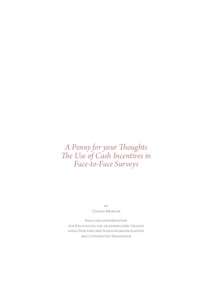|
A penny for your thoughts - the use of cash incentives in face-to-face surveys
Krieger, Ulrich
![[img]](https://madoc.bib.uni-mannheim.de/45606/1.hassmallThumbnailVersion/Krieger_Dissertation_20180719.pdf)  Vorschau |
|
PDF
Krieger_Dissertation_20180719.pdf
- Veröffentlichte Version
Download (2MB)
|
|
URL:
|
https://madoc.bib.uni-mannheim.de/45606
|
|
URN:
|
urn:nbn:de:bsz:180-madoc-456064
|
|
Dokumenttyp:
|
Dissertation
|
|
Erscheinungsjahr:
|
2018
|
|
Ort der Veröffentlichung:
|
Mannheim
|
|
Hochschule:
|
Universität Mannheim
|
|
Gutachter:
|
Blom, Annelies
|
|
Datum der mündl. Prüfung:
|
27 Februar 2018
|
|
Sprache der Veröffentlichung:
|
Englisch
|
|
Einrichtung:
|
Außerfakultäre Einrichtungen > SFB 884
Fakultät für Sozialwissenschaften > Data Science (Blom 2017-2022)
|
|
Lizenz:
|
 Creative Commons Namensnennung 4.0 International (CC BY 4.0)
Creative Commons Namensnennung 4.0 International (CC BY 4.0)
|
|
Fachgebiet:
|
300 Sozialwissenschaften, Soziologie, Anthropologie
|
|
Normierte Schlagwörter (SWD):
|
Empirische Sozialforschung
|
|
Freie Schlagwörter (Englisch):
|
Survey Methodology, Respondent Incentives, face-to-face-survey, survey cost, sample composition
|
|
Abstract:
|
The main body of this dissertation are three experiments on respondent incentives.
The incentive experiments have similarities but also cover different aspects of incentive
use. All experiments are conducted in the first wave of a longitudinal study
with the goal to motivate respondents not only to participate in one survey, but to
stay for the long haul. All experiments include at least one condition, offering cash
incentives upfront without any strings attached (unconditional cash incentives).
The first experiment I present in chapter 5 is comparing unconditional cash incentives
to conditional cash incentives in the GIP recruitment survey. I present
effects on response rate and sample composition. The added twist to this experiment
is that the values of both types of incentive are chosen in a way that their total
cost is the same: payinge10 offered conditionally to about half the (responding)
sample members compared to e5 sent unconditionally to all sample members.
Incentive effects in this experiment are thus measured under the realistic assumption
of a fixed survey budged, that needs to be used most effectively on an incentive
scheme.
The cost aspect is expanded on chapter 6 when discussing the GIP reminder
incentive experiment. Here I compare registration rates to the GIP online panel
conditional on receiving an unconditional cash incentive with a reminder letter
to just receiving the reminder. In addition to reporting on registration rates and
sample composition I examine if the use of the cash incentive was cost effective
for the GIP project.
Finally, I included the results of the SHARE Germany wave 4 incentive experiment
form 2011. Parts of the results presented in chapter 7 are taken from a working
paper on this topic (Börsch-Supan, Krieger, & Schröder, 2013). However, the results fit nicely into the present volume and the presentation has been improved
and the findings are still relevant for todays survey researchers:Testing unconditional
cash incentives of high value in a setting of a large, national face-to-face
study.
4
|
 | Dieser Eintrag ist Teil der Universitätsbibliographie. |
 | Das Dokument wird vom Publikationsserver der Universitätsbibliothek Mannheim bereitgestellt. |
 Suche Autoren in Suche Autoren in
Sie haben einen Fehler gefunden? Teilen Sie uns Ihren Korrekturwunsch bitte hier mit: E-Mail
Actions (login required)
 |
Eintrag anzeigen |
|
|
